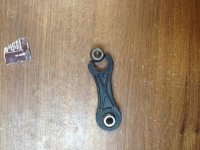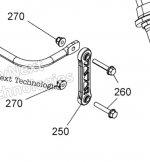DickB
Active member
HOW exactly do they work better than stock? I get that plastic is more flexible than metal, but I can't see how the stock links flex even a millimeter. I shot this slowmo video going over bumps and I'm not seeing any flex. If the flex is so small that it can't be seen, HOW does that make a difference? On smooth pavement, the A arms aren't moving, the end links aren't moving, the sway bar has no torsion. How can metal links make a difference in that case?
(I'm not talking about aftermarket sway bars - this is about end links only.)
Here are some comments from the Riker Mods Facebook group:
"I have them and what difference it maid with how the bike handles at high speeds"
"definetely recommend the baja ron sway bar and end links made a hugee difference for me"
"You won't be disappointed..its a noticeable change...keeps you from floating feeling...in my opinion"
"The sway bar link smooths the motion transfer between the sway bar and the control arm."
Please explain HOW they do this. Why is the motion of the stock links not "smooth"?
"I noticed the handling difference before I got out of the neighborhood. And, on the highway, my bike didnt hobble and float anymore, like none, it was fixed!"
"The noticable change is that it helps with body roll a little better which in turn affects how your cornering abilities."
Please explain how metal links help with body roll more than stock links.
"The Baja Ron are NOT plastic, so are stiffer and there is no “give” under those same riding conditions thus that squirrelly feeling goes away."
How much "give" do you think the stock links have? I'm not seeing any.
Most comments are along these lines. Fewer have tried them and noticed no difference. If there is a noticeable difference, WHAT is the mechanism that does this?
The first slomo video is the right side, hard left turn, aggressive enough to wake up the Stability Control nanny. The camera shifted down a bit so you can't see the top of the end link, but you can see enough. Using the bolt in the upper center of the video as a reference, you can see how much the A arm moved. Do you see any flex in the stock end link?
The second slomo video is going over some bumps in the pavement.
(I'm not talking about aftermarket sway bars - this is about end links only.)
Here are some comments from the Riker Mods Facebook group:
"I have them and what difference it maid with how the bike handles at high speeds"
"definetely recommend the baja ron sway bar and end links made a hugee difference for me"
"You won't be disappointed..its a noticeable change...keeps you from floating feeling...in my opinion"
"The sway bar link smooths the motion transfer between the sway bar and the control arm."
Please explain HOW they do this. Why is the motion of the stock links not "smooth"?
"I noticed the handling difference before I got out of the neighborhood. And, on the highway, my bike didnt hobble and float anymore, like none, it was fixed!"
"The noticable change is that it helps with body roll a little better which in turn affects how your cornering abilities."
Please explain how metal links help with body roll more than stock links.
"The Baja Ron are NOT plastic, so are stiffer and there is no “give” under those same riding conditions thus that squirrelly feeling goes away."
How much "give" do you think the stock links have? I'm not seeing any.
Most comments are along these lines. Fewer have tried them and noticed no difference. If there is a noticeable difference, WHAT is the mechanism that does this?
The first slomo video is the right side, hard left turn, aggressive enough to wake up the Stability Control nanny. The camera shifted down a bit so you can't see the top of the end link, but you can see enough. Using the bolt in the upper center of the video as a reference, you can see how much the A arm moved. Do you see any flex in the stock end link?
The second slomo video is going over some bumps in the pavement.


